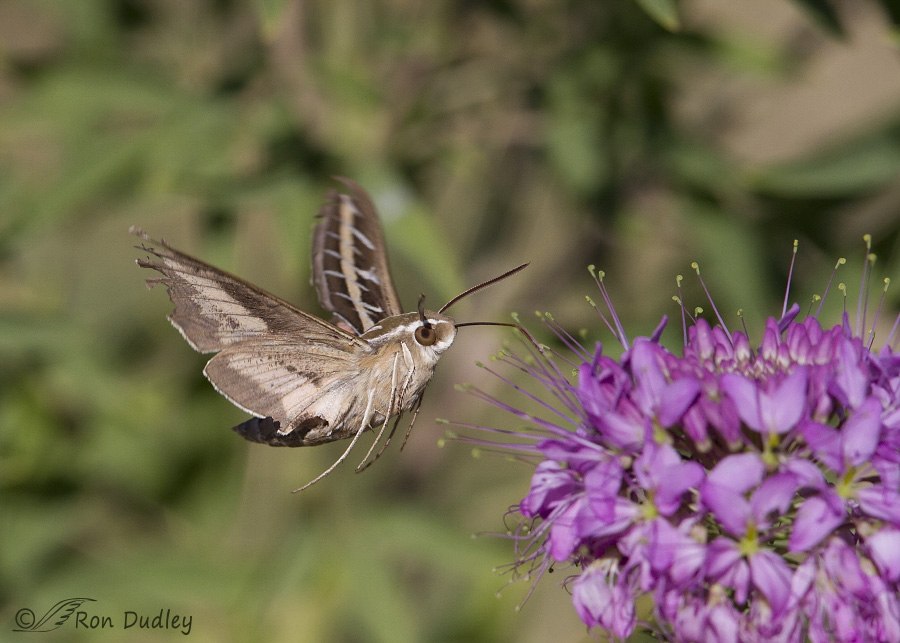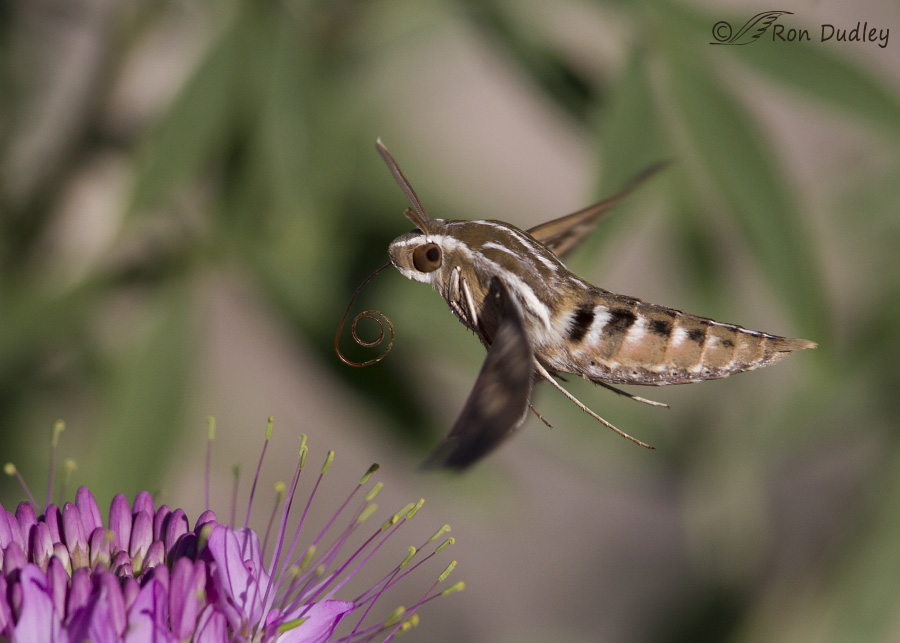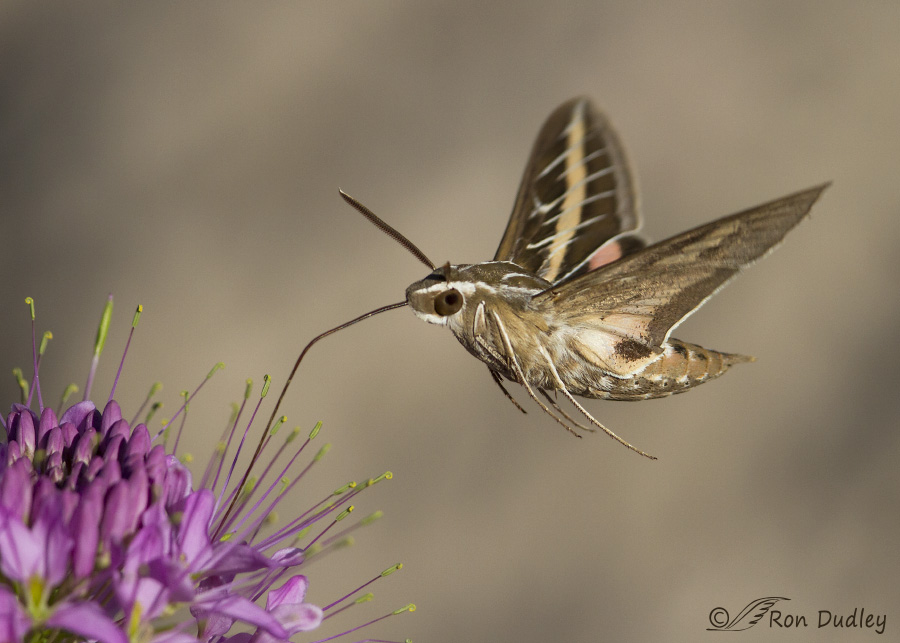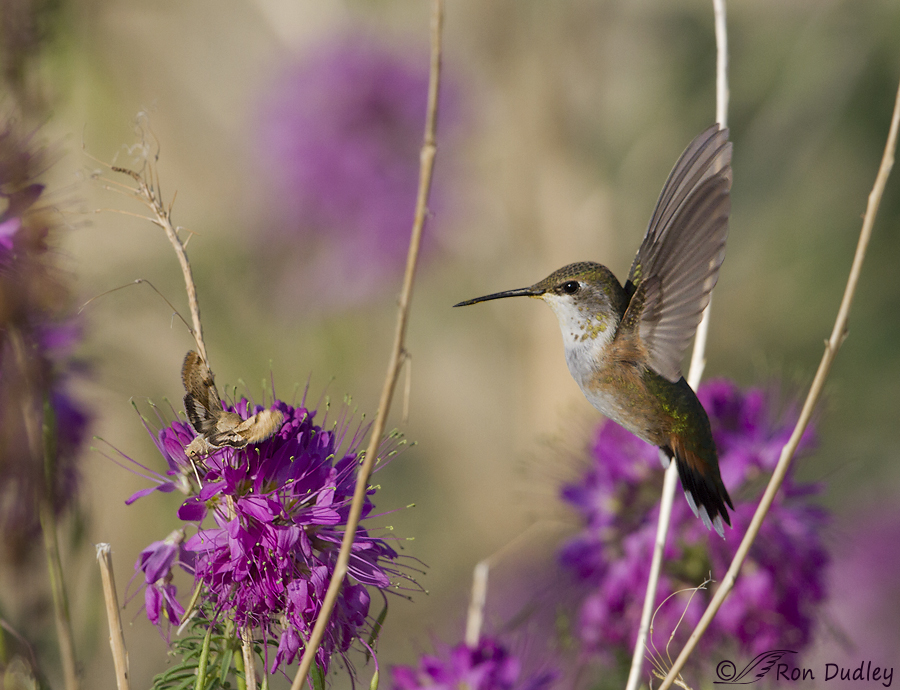When I bought my 500mm lens I never imagined that one day I’d be using that monster to photograph insects in flight. But that’s what happened over a period of several days in August of 2014 and I had a blast doing it.

1/4000, f/7.1, ISO 640, Canon 7D Mark II, Canon EF 500mm f/4L IS II USM, natural setting, not set up
White-lined Sphinx Moths are also called hummingbird moths for their large size and similarity in hovering flight habits and feeding methods to those birds – a spectacular example of convergent evolution. They were feeding on the nectar of Rocky Mountain Bee Plant on Antelope Island by dipping their long, curled proboscis into the flowers. Like hummingbirds they would hover and feed on one flower cluster for a few moments and then flit to another. Those delicate wings move very fast and they take a lot of abuse so this moth had tattered wings as a result.

1/2500, f/5.6, ISO 500, Canon 7D Mark II, Canon EF 500mm f/4L IS II USM, natural setting, not set up
I needed very fast shutter speeds to get the wings sharp and I didn’t have enough of it here so they’re soft. Anyone who photographs hummingbirds knows that you need fast SS’s to get those buzz-saw wings sharp but these insects have hummingbirds beat when it comes to wing speed. Bats generate about 17 wingbeats per second and hummingbirds about 50 wingbeats per second but sphinx moths top them all at 85 beats per second.
I also include this image to show that interesting and very long proboscis. Here it’s in an intermediate position between being extended almost straight out while its feeding and a tightly coiled position under the “chin”. When extended the proboscis is almost as long as the body.
 1/4000, f/5.6, ISO 500, Canon 7D Mark II, Canon EF 500mm f/4L IS II USM, natural setting, not set up
1/4000, f/5.6, ISO 500, Canon 7D Mark II, Canon EF 500mm f/4L IS II USM, natural setting, not set up
Here the proboscis is extended deep into the flower while the insect is hovering and feeding. This is one of the relatively few images where I caught a moth against a clean background.
I’m absolutely fascinated by that eye. Notice that in these three images the dark spot or “pseudo-pupil” appears to change position in the eye but in reality it’s simply the patch of compound eye facets that is absorbing most of the light from the direction of the observer. The patch seems to move, when in fact what you’re seeing is a new patch of light-absorbing facets as the moth changes position relative to the observer.
The time I spent with these moths was superb training for my in-flight tracking and focusing skills. While they are large for an insect they’re smaller and even faster than hummingbirds so it was both challenging and hugely rewarding to get a sharp shot (I just about wore out my delete key while culling these images).
There was very little Rocky Mountain Bee Plant on the island last summer so I was moth-skunked but I’m hoping that next summer will be different.
Ron
Addendum: I’m adding this image in response to comments below by Dick Harlow and Patty Chadwick.



These pics are wonderful. These beauties come to my Butterfly Bushes every summer and I just love watching them. Thanks so much
Spectacular! I would say the moth’s wingspan is about as wide as the hummer’s bill and head are long. Great chance to see the size of those fast movers frozen in relation to each other.
And thanks for the info about the eye. I always wondered if they had a large pupil.
Fantastic!
Thanks, Nicole.
Absolutely stunning!! Thank you for sharing your great talent, vast knowledge and hard work with us!
Thank you, Jane.
Wow, wow and wow.
If we take the time to look, to really look, we are rewarded so very generously.
Thank you for always taking that time. And sharing it.
Yup, being observant and paying attention is the key, EC. Thank you.
Really enjoyed this. I’ve never seen the moth live but I’ve seen the hummingbirds. Getting ready to put out my feeders. Well, not really but dang it, I want to.
I know what you mean, Arwen. I really look forward to seeing hummers again.
Thank you…didn’t realize moth was so much smaller…think this may have been an extra small moth…great picture of a hummer!!!
“think this may have been an extra small moth”
You could be right, Patty. I remember them as being over half the size of the hummers.
WOW! This Hummer is significantly larger than the moth – I’ll have to re-evaluate our Clearwing Moth comparison to the Ruby-throated Hummingbird.
Many thanks for adding to your post!
You’re very welcome, Dick. I remembered these moths as being larger than they appear in this image too.
85 beats per second!!! I had no clue. Amazing that you were able to “freeze” anything that fast! We had a Butterfly bush that attracted 3,4 sometimes more of them at a time…would love to see the photo of the two together. A very interesting blog, a very interesting insect. Love that Cleome, too.
“would love to see the photo of the two together”
Your wish is my command, Patty. Done.
Gorgeous as usual…what an amazing adaptation! Ah the diversity on this spinning rock! Wish more humans appreciated that.
“Wish more humans appreciated that”
That would go a long ways toward solving a lot of problems, wouldn’t it, Laura.
Now you’re more in my league – Fantastic shots with a huge lens! As much as I love ALL your shots, I tend to concentrate my photography on close-up to macro. Probably why, besides the area I shoot in, I haven’t gone with a bigger lens.
Questions – were you in your truck when you took these shots? Approx. how big are these Sphinx Moths compared to a hummingbird?
We have hummingbird moths here as well, but a different species then yours and they are slightly smaller than a hummer.
Man, I would probably wase a ton of battery power on these fellows1
Many thanks for the post!
Dick, yes, I was in my truck for all these shots.
I have one shot that includes both a moth and a Rufous Hummingbird. I’d estimate that the insect is less than half the size of the hummer but it’s a little hard to tell for sure.
Extraordinary. I note their eyes. How strange and beautiful.
Agreed, Sallie – those eyes are something else.
Cool! We have them around here occasionally and they are fascinating.
We have them around here occasionally and they are fascinating.  The first time we saw one we thought it was a hummer, BUT! The curled proboscis is an interesting adaptation. Thx for the eye information. Wouldn’t even want to try one with a macro lens!
The first time we saw one we thought it was a hummer, BUT! The curled proboscis is an interesting adaptation. Thx for the eye information. Wouldn’t even want to try one with a macro lens!
Judy, their similarity to hummingbirds is amazing. Covergent evolution at its best.
How beautiful!
Charlotte
Thank you, Charlotte.
Uh-oh Ron! Do I see a macro lens in your future? Fabulous shots! Love the second image with the proboscis coiled!
“Do I see a macro lens in your future?”
I hope not, Nancy. Might have to buy a utility trailer to haul all my gear around behind my pickup…